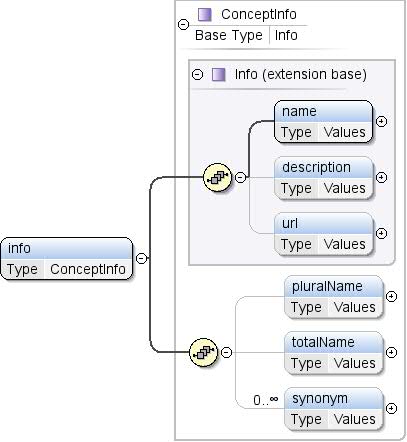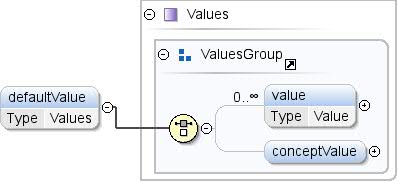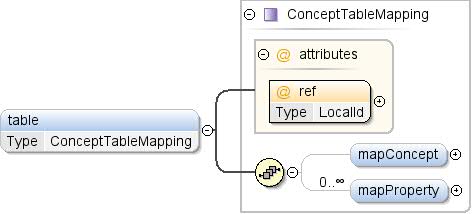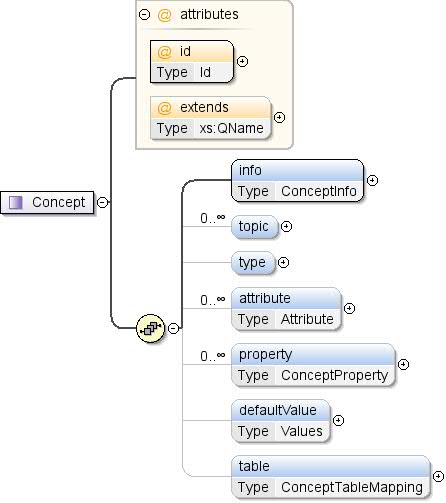구성요소: 개념
컬렉션을 사용해 정리하기
내 환경설정을 기준으로 콘텐츠를 저장하고 분류하세요.
요소: 개념 / 정보
| 네임스페이스 |
http://schemas.google.com/dspl/2010 |
| 주석 |
제품 또는 서비스의 이름 및 설명과 같은
살펴보겠습니다 |
| 다이어그램 |
 |
| 유형 |
ConceptInfo |
| 유형 계층 구조 |
-
정보
<ph type="x-smartling-placeholder">
|
| 속성 |
|
| 모델 |
이름 , 설명{0,1} , url{0,1} , pluralName{0,1} , totalName{0,1} , 동의어* |
| 어린이 |
description, name, pluralName,
동의어, totalName, url |
| 인스턴스 |
<info>
<name>{1,1}</name>
<description>{0,1}</description>
<url>{0,1}</url>
</info>
|
| 소스 |
<xs:element name="info" type="ConceptInfo">
<xs:annotation>
<xs:documentation>Textual information, such as the name and description of
the concept.</xs:documentation>
</xs:annotation>
</xs:element>
|
요소: 개념 / 주제
| 네임스페이스 |
http://schemas.google.com/dspl/2010 |
| 주석 |
개념과 관련된 주제. |
| 다이어그램 |
 |
| 속성 |
| content: |
복잡함 |
| minOccurs: |
0 |
| maxOccurs: |
unbounded |
|
| 속성 |
| QName |
유형 |
고정 |
기본값 |
사용 |
Annotation |
| 참조 |
xs:QName |
|
|
선택사항 |
이 개념에 해당하는 주제의 고유 식별자입니다.
알 수 있습니다. 참조된 주제는
데이터 세트 또는 외부, 즉 다른 데이터 세트에
데이터를 저장합니다 참조는
외부 주제는 다음 형식이어야 합니다.
'prefix:other_topic_id', 여기서 'prefix' 는
외부 데이터 세트의 네임스페이스에 사용되는 프리픽스입니다 (XML 참조).
네임스페이스) |
|
| 소스 |
<xs:element name="topic" minOccurs="0" maxOccurs="unbounded">
<xs:annotation>
<xs:documentation>A topic the concept is associated with.</xs:documentation>
</xs:annotation>
<xs:complexType>
<xs:attribute name="ref" type="xs:QName">
<xs:annotation>
<xs:documentation>The unique identifier of the topic this concept is
associated with.
The referenced topic may be defined in the same
dataset or externally, i.e., in another dataset. A
reference to an external topic must be of the form
"prefix:other_topic_id", where "prefix" is the prefix
used for the namespace of the external dataset (see
XML namespaces).</xs:documentation>
</xs:annotation>
</xs:attribute>
</xs:complexType>
</xs:element>
|
요소: 개념 / 유형
| 네임스페이스 |
http://schemas.google.com/dspl/2010 |
| 주석 |
개념의 데이터 유형입니다. 개념은 유형을 제공해야 합니다.
선언하거나 다른 개념을 확장합니다. 인코더-디코더 아키텍처를
유형 선언을 제공할 수도 있습니다. 유형
확장된 개념은
그것을 확장하는 개념입니다. '다음보다 작음' (LRT)는
부분 순서는 다음과 같이 정의됨: 문자열 LRT 부동 소수점 수 LRT 정수
문자열 LRT 날짜 문자열 LRT 불리언 |
| 다이어그램 |
 |
| 속성 |
| content: |
복잡함 |
| minOccurs: |
0 |
|
| 속성 |
|
| 소스 |
<xs:element name="type" minOccurs="0">
<xs:annotation>
<xs:documentation>The data type of the concept. A concept must provide a type declaration or extend
another concept. In the case where it's extending a concept, it may also
provide a type declaration. The type of the extended concept must be less restrictive
than the type of the concept extending it.
"Less restrictive than" (LRT) is a partial order defined as follows:
string LRT float
float LRT integer
string LRT date
string LRT boolean</xs:documentation>
</xs:annotation>
<xs:complexType>
<xs:attribute name="ref" type="DataType" use="required"/>
</xs:complexType>
</xs:element>
|
요소: 개념 / 속성
| 네임스페이스 |
http://schemas.google.com/dspl/2010 |
| 주석 |
개념의 속성입니다. 속성은
개념에 대한 정보 (예: GDP는 백분율입니다.) |
| 다이어그램 |
 |
| 유형 |
속성 |
| 속성 |
| content: |
복잡함 |
| minOccurs: |
0 |
| maxOccurs: |
unbounded |
|
| 모델 |
info{0,1} , type{0,1} , (값*
| conceptValue{0,1}) |
| 어린이 |
conceptValue, info, type
값 |
| 인스턴스 |
<attribute concept="" id="">
<info>{0,1}</info>
<type format="" ref="">{0,1}</type>
</attribute>
|
| 속성 |
| QName |
유형 |
고정 |
기본값 |
사용 |
Annotation |
| 개념 |
xs:QName |
|
|
선택사항 |
값에 해당하는 개념에 대한 참조입니다.
속성입니다. 속성이 유형을 지정하는 경우 유형은
참조된 개념의 유형과 일치해야 합니다. 참조는
외부 개념은
'prefix:other_concept_id', 여기서 'prefix' 은
외부 데이터 세트의 네임스페이스에 사용되는 프리픽스입니다 (XML 참고).
네임스페이스) |
| id |
LocalId |
|
|
선택사항 |
개념 속성의 ID입니다. 식별자는
특성과 속성에 걸쳐 개념 내에서 고유합니다. 이
concept 속성이 지정된 경우 id는 생략할 수 있습니다. 그 안에서
이 경우 ID는
참조된 개념입니다. 예: <attribute
concept="unit:currency"/> 위 항목은 다음과 동일합니다.
<attribute id="currency"
concept="unit:currency"/> |
|
| 소스 |
<xs:element name="attribute" type="Attribute" minOccurs="0" maxOccurs="unbounded">
<xs:annotation>
<xs:documentation>An attribute of the concept. Attributes represent additional
information about the concept (e.g., GDP is a percentage).</xs:documentation>
</xs:annotation>
</xs:element>
|
요소: 개념 / 속성
| 네임스페이스 |
http://schemas.google.com/dspl/2010 |
| 주석 |
개념의 속성입니다. 속성은
개념의 인스턴스에 대한 정보 (예:
'도시' 'country') 속성을 가질 수 있습니다. |
| 다이어그램 |
 |
| 유형 |
ConceptProperty |
| 속성 |
| content: |
복잡함 |
| minOccurs: |
0 |
| maxOccurs: |
unbounded |
|
| 모델 |
info{0,1} , 유형{0,1} |
| 어린이 |
정보, 유형 |
| 인스턴스 |
<property concept="" id="" isMapping="false" isParent="false">
<info>{0,1}</info>
<type ref="">{0,1}</type>
</property>
|
| 속성 |
| QName |
유형 |
고정 |
기본값 |
사용 |
Annotation |
| 개념 |
xs:QName |
|
|
선택사항 |
값에 해당하는 개념에 대한 참조입니다.
속성입니다. 속성이 유형을 지정하는 경우 유형은
참조된 개념의 유형과 일치해야 합니다. 참조는
외부 개념은
'prefix:other_concept_id', 여기서 'prefix' 은
외부 데이터 세트의 네임스페이스에 사용되는 프리픽스입니다 (XML 참고).
네임스페이스) |
| id |
LocalId |
|
|
선택사항 |
개념 속성의 ID입니다. 식별자는
특성과 속성에 걸쳐 개념 내에서 고유합니다. 이
concept 속성이 지정된 경우 id는 생략할 수 있습니다. 그 안에서
경우 ID는
참조된 개념입니다. 예: <property
concept="geo:country"/> <property>와 동일합니다.
id="country"
concept="geo:country"/> |
| isMapping |
xs:boolean |
|
거짓 |
선택사항 |
true인 경우 이 속성은 개념을 참조해야 합니다.
이 속성은
참조된 개념이 있습니다. 참조된
개념은 이 객체의 최대 한 인스턴스에서 참조됩니다.
있습니다. |
| isParent |
xs:boolean |
|
거짓 |
선택사항 |
true인 경우 이 속성은 개념을 참조해야 합니다.
이 속성은
참조된 개념 (예: 한 대륙이 있는 대륙)
국가). |
|
| 소스 |
<xs:element name="property" type="ConceptProperty" minOccurs="0" maxOccurs="unbounded">
<xs:annotation>
<xs:documentation>A property of the concept. Properties represent additional
information about instances of the concept (e.g., a concept
"city" may have a property "country").</xs:documentation>
</xs:annotation>
</xs:element>
|
요소: 개념 / defaultValue
| 네임스페이스 |
http://schemas.google.com/dspl/2010 |
| 주석 |
애플리케이션에서 사용할 개념의 기본값입니다.
이 예측값의 가능한 값 중 하나를 선택해야 할 때
살펴보겠습니다 |
| 다이어그램 |
 |
| 유형 |
값 |
| 속성 |
| content: |
복잡함 |
| minOccurs: |
0 |
|
| 모델 |
값* | conceptValue{0,1} |
| 어린이 |
conceptValue, value |
| 인스턴스 |
<defaultValue>
<value lang="">{0,unbounded}</value>
<conceptValue concept="">{0,1}</conceptValue>
</defaultValue>
|
| 소스 |
<xs:element name="defaultValue" type="Values" minOccurs="0">
<xs:annotation>
<xs:documentation>A default value for the concept, to be used by
applications when they need to pick one of the possible
values of the concept.</xs:documentation>
</xs:annotation>
</xs:element>
|
요소: 개념 / 테이블
| 네임스페이스 |
http://schemas.google.com/dspl/2010 |
| 주석 |
가능한 모든 값이 포함된 테이블에 대한 참조입니다.
상수가 아닙니다. |
| 다이어그램 |
 |
| 유형 |
ConceptTableMapping |
| 속성 |
| content: |
복잡함 |
| minOccurs: |
0 |
|
| 모델 |
mapConcept{0,1} , mapProperty* |
| 어린이 |
mapConcept, mapProperty |
| 인스턴스 |
<table ref="">
<mapConcept toColumn="">{0,1}</mapConcept>
<mapProperty lang="" ref="" toColumn="">{0,unbounded}</mapProperty>
</table>
|
| 속성 |
| QName |
유형 |
고정 |
기본값 |
사용 |
Annotation |
| 참조 |
LocalId |
|
|
필수 |
살펴보겠습니다 |
|
| 소스 |
<xs:element name="table" type="ConceptTableMapping" minOccurs="0">
<xs:annotation>
<xs:documentation>A reference to a table that contains all the
possible values for the concept and its non-constant
properties.</xs:documentation>
</xs:annotation>
</xs:element>
|
복합 유형: 개념
| 네임스페이스 |
http://schemas.google.com/dspl/2010 |
| 주석 |
개념은 분석 자료에 나타나는 데이터 유형의 정의입니다.
데이터 세트 (예: 'GDP' 또는 '카운티'). 개념은
모든 가능한 값의 열거와 관련되어 있는지 여부를 지정합니다. 가
일부 데이터 세트에 정의된 개념이 다른 데이터 세트에 참조될 수 있음
데이터 세트도 제공합니다. |
| 다이어그램 |
 |
| 사용 주체 |
|
| 모델 |
info , topic* , type{0,1} ,
attribute* , property* , defaultValue{0,1} , table{0,1} |
| 어린이 |
attribute, defaultValue, info,
속성, 표, 주제,
유형 |
| 속성 |
| QName |
유형 |
고정 |
기본값 |
사용 |
Annotation |
| 확장 |
xs:QName |
|
|
선택사항 |
이 개념이 제공하는 개념의 고유 식별자입니다.
확장됩니다. 참조된 개념이 동일한 데이터 세트에 정의될 수 있습니다.
데이터를 공유할 수 있습니다 외부
개념은 'prefix:other_concept_id' 형식이어야 합니다.
여기서 'prefix' 는
외부 데이터 세트 (XML 네임스페이스 참고) |
| id |
ID |
|
|
필수 |
개념의 고유 식별자로서
데이터 세트 내에서 전역적으로 고유합니다. |
|
| 소스 |
<xs:complexType name="Concept">
<xs:annotation>
<xs:documentation>A concept is a definition of a type of data that appears in the
dataset (e.g., "GDP" or "County"). A concept may be associated with
an enumeration of all its possible values or not. A concept defined in
some dataset may be referenced in other datasets.</xs:documentation>
</xs:annotation>
<xs:sequence>
<xs:element name="info" type="ConceptInfo">
<xs:annotation>
<xs:documentation>Textual information, such as the name and description of
the concept.</xs:documentation>
</xs:annotation>
</xs:element>
<xs:element name="topic" minOccurs="0" maxOccurs="unbounded">
<xs:annotation>
<xs:documentation>A topic the concept is associated with.</xs:documentation>
</xs:annotation>
<xs:complexType>
<xs:attribute name="ref" type="xs:QName">
<xs:annotation>
<xs:documentation>The unique identifier of the topic this concept is
associated with.
The referenced topic may be defined in the same
dataset or externally, i.e., in another dataset. A
reference to an external topic must be of the form
"prefix:other_topic_id", where "prefix" is the prefix
used for the namespace of the external dataset (see
XML namespaces).</xs:documentation>
</xs:annotation>
</xs:attribute>
</xs:complexType>
</xs:element>
<xs:element name="type" minOccurs="0">
<xs:annotation>
<xs:documentation>The data type of the concept. A concept must provide a type declaration or extend
another concept. In the case where it's extending a concept, it may also
provide a type declaration. The type of the extended concept must be less restrictive
than the type of the concept extending it.
"Less restrictive than" (LRT) is a partial order defined as follows:
string LRT float
float LRT integer
string LRT date
string LRT boolean</xs:documentation>
</xs:annotation>
<xs:complexType>
<xs:attribute name="ref" type="DataType" use="required"/>
</xs:complexType>
</xs:element>
<xs:element name="attribute" type="Attribute" minOccurs="0" maxOccurs="unbounded">
<xs:annotation>
<xs:documentation>An attribute of the concept. Attributes represent additional
information about the concept (e.g., GDP is a percentage).</xs:documentation>
</xs:annotation>
</xs:element>
<xs:element name="property" type="ConceptProperty" minOccurs="0" maxOccurs="unbounded">
<xs:annotation>
<xs:documentation>A property of the concept. Properties represent additional
information about instances of the concept (e.g., a concept
"city" may have a property "country").</xs:documentation>
</xs:annotation>
</xs:element>
<xs:element name="defaultValue" type="Values" minOccurs="0">
<xs:annotation>
<xs:documentation>A default value for the concept, to be used by
applications when they need to pick one of the possible
values of the concept.</xs:documentation>
</xs:annotation>
</xs:element>
<xs:element name="table" type="ConceptTableMapping" minOccurs="0">
<xs:annotation>
<xs:documentation>A reference to a table that contains all the
possible values for the concept and its non-constant
properties.</xs:documentation>
</xs:annotation>
</xs:element>
</xs:sequence>
<xs:attribute name="id" type="Id" use="required">
<xs:annotation>
<xs:documentation>The unique identifier of the concept, which must be globally
unique within the dataset.</xs:documentation>
</xs:annotation>
</xs:attribute>
<xs:attribute name="extends" type="xs:QName" use="optional">
<xs:annotation>
<xs:documentation>The unique identifier of a concept that this
concept extends.
The referenced concept may be defined in the same
dataset or externally, i.e., in another dataset. A
reference to an external concept must be of the form
"prefix:other_concept_id", where "prefix" is the
prefix used for the namespace of the external
dataset (see XML namespaces).</xs:documentation>
</xs:annotation>
</xs:attribute>
</xs:complexType>
|
속성: 개념 / 주제 / @ref
| 네임스페이스 |
네임스페이스 없음 |
| 주석 |
이 개념과 연관된 주제의 고유 식별자입니다.
있습니다. 참조된 주제가 동일한 데이터 세트에 정의될 수 있습니다.
외부, 즉 다른 데이터 세트에 저장된
데이터입니다 외부 주제 참조
'prefix:other_topic_id' 형식이어야 합니다.
'프리픽스' 는 외부 네임스페이스의 네임스페이스에 사용되는
데이터 세트 (XML 네임스페이스 참고) |
| 유형 |
xs:QName |
| 속성 |
|
| 사용 주체 |
|
| 소스 |
<xs:attribute name="ref" type="xs:QName">
<xs:annotation>
<xs:documentation>The unique identifier of the topic this concept is
associated with.
The referenced topic may be defined in the same
dataset or externally, i.e., in another dataset. A
reference to an external topic must be of the form
"prefix:other_topic_id", where "prefix" is the prefix
used for the namespace of the external dataset (see
XML namespaces).</xs:documentation>
</xs:annotation>
</xs:attribute>
|
속성: 개념 / 유형 / @ref
| 네임스페이스 |
네임스페이스 없음 |
| 유형 |
DataType |
| 속성 |
|
| 패싯 |
| 열거형 |
문자열 |
|
| 열거형 |
float |
|
| 열거형 |
정수 |
|
| 열거형 |
부울 |
|
| 열거형 |
날짜 |
|
| 열거형 |
개념 |
|
|
| 사용 주체 |
|
| 소스 |
<xs:attribute name="ref" type="DataType" use="required"/>
|
속성: 개념 / @id
| 네임스페이스 |
네임스페이스 없음 |
| 주석 |
개념의 고유 식별자로, 전역적으로 지정되어야 합니다.
고유합니다. |
| 유형 |
ID |
| 속성 |
|
| 패싯 |
|
| 사용 주체 |
|
| 소스 |
<xs:attribute name="id" type="Id" use="required">
<xs:annotation>
<xs:documentation>The unique identifier of the concept, which must be globally
unique within the dataset.</xs:documentation>
</xs:annotation>
</xs:attribute>
|
속성: 개념 / @extends
| 네임스페이스 |
네임스페이스 없음 |
| 주석 |
이 개념이 확장하는 개념의 고유 식별자입니다.
참조된 개념은 동일한 데이터 세트 또는 외부에서 정의할 수 있습니다.
다른 데이터 세트에서 찾을 수 있습니다. 외부 개념에 대한 참조는
'prefix:other_concept_id' 형식이며 여기서 'prefix' 은
외부 데이터 세트의 네임스페이스에 사용되는 프리픽스입니다 (XML 참고).
네임스페이스) |
| 유형 |
xs:QName |
| 속성 |
|
| 사용 주체 |
|
| 소스 |
<xs:attribute name="extends" type="xs:QName" use="optional">
<xs:annotation>
<xs:documentation>The unique identifier of a concept that this
concept extends.
The referenced concept may be defined in the same
dataset or externally, i.e., in another dataset. A
reference to an external concept must be of the form
"prefix:other_concept_id", where "prefix" is the
prefix used for the namespace of the external
dataset (see XML namespaces).</xs:documentation>
</xs:annotation>
</xs:attribute>
|
다음을 사용하여 생성:
oXygen XML 편집기.
달리 명시되지 않는 한 이 페이지의 콘텐츠에는 Creative Commons Attribution 4.0 라이선스에 따라 라이선스가 부여되며, 코드 샘플에는 Apache 2.0 라이선스에 따라 라이선스가 부여됩니다. 자세한 내용은 Google Developers 사이트 정책을 참조하세요. 자바는 Oracle 및/또는 Oracle 계열사의 등록 상표입니다.
최종 업데이트: 2025-07-25(UTC)
[[["이해하기 쉬움","easyToUnderstand","thumb-up"],["문제가 해결됨","solvedMyProblem","thumb-up"],["기타","otherUp","thumb-up"]],[["필요한 정보가 없음","missingTheInformationINeed","thumb-down"],["너무 복잡함/단계 수가 너무 많음","tooComplicatedTooManySteps","thumb-down"],["오래됨","outOfDate","thumb-down"],["번역 문제","translationIssue","thumb-down"],["샘플/코드 문제","samplesCodeIssue","thumb-down"],["기타","otherDown","thumb-down"]],["최종 업데이트: 2025-07-25(UTC)"],[],["Concepts, within a dataset (namespace: `http://schemas.google.com/dspl/2010`), define data types and are globally unique. Concepts can extend others, using `prefix:other_concept_id` for external references. They include `info` (textual details), `topic` (associated topics via `ref`), `type` (data type, `ref`), `attribute` (additional information), `property` (instance information), `defaultValue`, and `table` (data source, `ref`). Key concept attributes are `id` (unique), and `extends` (referencing another concept). External references are in `prefix:identifier` format. A concept must have a `type` or `extends`.\n"]]








